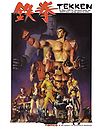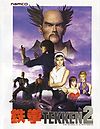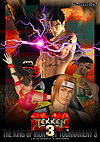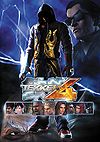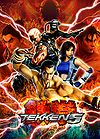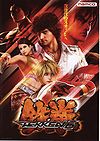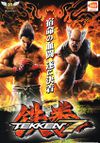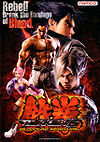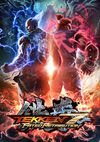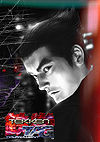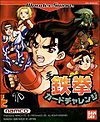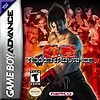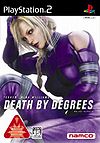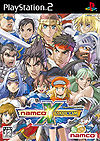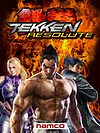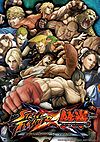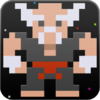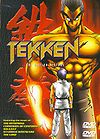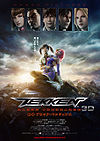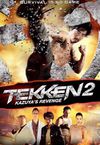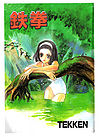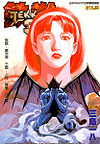Tekken (series)
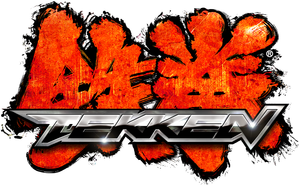
| |
| Platforms | Arcades, PlayStation 1, Wonder Swan, PlayStation 2, Game Boy Advance, PlayStation Portable, PlayStation 3, Xbox 360, Nintendo 3DS, Wii U, PC, iOS, Android, Playstation 4, Xbox One, Steam |
| Release Date | December, 1994 |
| Arcade System | Namco System 11 Namco System 12 Namco System 246 Namco System 256 Namco System 356 Namco System 369 Unreal Engine 4 |
| Genre | Fighting |
| Game modes | Single-player, multiplayer |
| Predecessor | — |
| Followed By | — |
| Official site | http://www.tekken-official.jp/ |
- This article is about the series. For the first game in the series, see Tekken.
- This article is about the series. For the live action film, see Tekken (2010 Film).
Tekken is a series of fighting video games developed and produced by Namco. It is one of the earliest 3D fighting games drawing heavily on its predecessor, Virtua Fighter. Since then, however, it has become more of a unique game in its own right.
Both directors of Tekken and Virtua Fighter have shown interest several times in a crossover game of Tekken and Virtua Fighter. The same goes for the directors of Tekken and Street Fighter, which is, after 16 years, finally coming to fruition as the two games Tekken X Street Fighter and Street Fighter X Tekken.
Contents
Introduction[edit]
- See also: Tekken Storyline
Tekken is a series of fighting games developed and published by Namco. Originally an arcade game, versions exist for the PlayStation, PlayStation 2, PlayStation Portable, PlayStation 3, Xbox 360, Wonder Swan, Game Boy Advance, and Nintendo 3DS. To date, the series is one of Namco's best-selling franchises, with over 33 million units sold.
The story in each game in the series (with the exception of the non-canon games such as Tekken Tag Tournament and Tekken Tag Tournament 2) documents the events of the fictional martial arts tournament, The King of Iron Fist Tournament, with the game's chronological number corresponding with the current iteration of the tournament.The tournament is always hosted by a financial corporation called the "Mishima Zaibatsu", with the tournament prize generally being control of the company offered to the victor (who then is free to host the next King of Iron Fist tournament). Tekken 7, however hints a very strong change of pacing, in which it declares "The end of the Mishima saga".
The arcade versions are known to traditionally use PlayStation based hardware for each installment, and subsequently each arcade version was eventually made for its respective PlayStation. There are currently seven main instalments in the Tekken series, however starting with Tekken 6, Tekken has now been branching out to Xbox, and Wii U for Tekken Tag Tournament 2. Tekken 7's was also stated to use Unreal Engine 4. During a showcase of Unreal Engine 4's line up of games, Tekken 7 was prematurely mentioned to have ports in development for both Playstation 4 and Xbox One.
Games[edit]
Main Series[edit]
Tekken (Arcade, PlayStation, PSN)
Tekken 2 (Arcade, PlayStation, PSN)
Tekken 3 (Arcade, PlayStation)
Tekken 4 (Arcade, PS2)
Tekken 5 (Arcade, PS2)
Tekken 6 (Arcade, PS3, PSP, Xbox 360)
Tekken 7 (Arcade, PS4, Xbox One, Steam, PC)
Remakes & Upgrades[edit]
Tekken 5: Dark Resurrection (Arcade, PSP, PS3)
Tekken 6: Bloodline Rebellion (Arcade)
Tekken Hybrid (PS3)
Tekken 7: Fated Retribution (Arcade)
Spin-Offs[edit]
Tekken Tag Tournament (Arcade, PS2)
Tekken Card Challenge (WonderSwan)
Tekken Advance (GBA)
Death by Degrees (PS2)
Namco X Capcom (PS2)
Tekken Resolute (Mobile Phones)
Tekken Bowl (iOS)
Tekken Tag Tournament 2 (Arcade, PS3, Xbox 360, Wii U)
Street Fighter X Tekken (Arcade, PS3, PS Vita, PC, Xbox 360)
Tekken X Street Fighter (Arcade, PS3, Xbox 360)
Tekken 3D Prime Edition (3DS)
Tekken Card Tournament (PC, iOS, Android)
Tekken Revolution (PS3)
Galaga: TEKKEN Edition (Android)[1]
Tekken (Mobile) (Android, iOS)
Other Media[edit]
Film & Animation[edit]
Graphic Novels[edit]
Fighters[edit]
- See also: Category:Playable characters and Category:Non-playable characters
The Tekken series has a wide range of both playable and unplayable characters hailing from various parts of the world and specializing in different fighting styles. While the first games would have several characters with similar movesets, these have since then branched out so that even though certain characters train the same style of martial arts, they would have several unique moves.
While the first two games were very sparse in terms of character bios, but high in character data (i.e. height, age, blood type, etc.), this was changed in Tekken 3 where character bios were significantly expanded from being just two or three lines, and then again in Tekken 4 where character data other than age, nationality, and fighting style was removed from the official website bios and being present only in the art books.
By game[edit]
All canon (1 to 7), and Tag Tournament and Revolution games only.
Notes:
- Introduced or playable in Dark Resurrection.
- Introduced or playable in Bloodline Rebellion.
- Introduced or playable in Fated Retribution.
- Character swap, palette swap, transformation.
- Playable in console versions only.
- Unplayable boss or enemy character in arcade and/or home versions.
Stages[edit]
- See also: Category:Stages
The first Tekken game almost exclusively used famous locations around the world, but has since then gradually become a mix of real world locations and game unique stages.
Tekken 4 was the first game to implement actual walls, ceilings and stage obstacles, all other games until then simply having 'infinite' stages. Tekken 4 still remains the game with the most geometrically complex stages, as it also takes details such as a slant in the floor into account making it possible to sometimes duck under mid-range moves and even low-range moves in extreme cases. One could also use objects present as walls, e.g. a pillar or a phone booth, for wall combos, and certain launchers could slam the opponent into a ceiling, making it harder to juggle them in the specific spot.
Of this, Tekken 5 only kept the walls and re-introduced the infinite stages while Tekken 6 also introduced breakable walls and floors on certain stages.
Tekken Tag Tournament 2 then introduced a balcony break, which was also retained in Tekken Revolution, as with the breakable walls and floors.
Tekken 7, retained these features, but added more twists to it. On one stage, it was possible to break the floor thrice. Additionally, the standard "bound" state that the enemy would normally be left in during a balcony or floor break was changed to a bouncing state instead. The combo system was heavily revamped, with the scaling increased, encouraging players to use less moves in a combo.
Influence[edit]
The Tekken games are popular within the martial arts community thanks primarily to the fact that most of the characters' fighting techniques can be found in real life martial arts. However, there are questions as to the accuracy of the style labels ascribed to certain characters. For example, in previous releases of the game, the character Paul Phoenix is listed accurately as fighting using integrated martial arts based on judo, despite judo not generally allowing punching and kicking, especially in competition. Similarly, the character Marshall Law is listed as being a practitioner of "martial arts", which is not a specific discipline. Similarities exist between Marshall Law and Bruce Lee, including their fighting style, Jeet Kune Do as well as appearance. The misunderstanding concerning Marshall Law's "martial arts" is commonly attributed to the fact that in the manual for the American PlayStation release of Tekken 2, the translator for the manual missed a small pun where Marshall Law practiced 'Marshall arts', a reference to his own name. Other Tekken characters also draw heavily from real life action heroes, such as Lei Wulong and Craig Marduk, video game analogues of Jackie Chan, and large wrestlers/mixed martial artists, such as Bill Goldberg, Nathan Jones, and Bob Sapp. Namco themselves have stated that the styles in Tekken are not supposed to accurately represent real styles, but merely give the impression of them. Paul Phoenix, Nina Williams, Yoshimitsu and Heihachi Mishima have been playable characters in all Tekken games, while Lei Wulong first appeared as a playable character in Tekken 2 and has since shown up in all subsequent games. Kazuya Mishima and Lee Chaolan are playable characters in all Tekken games with the exception of Tekken 3, which Kazuya only appears or is mentioned in various cinematic. Anna Williams is playable in all Tekken games except Tekken 4. A member of the Law and Chang family have also been playable in every Tekken game.
Apart from Yoshimitsu, Heihachi Mishima and Lars Alexandersson, there are many crossovers between Tekken and the Soul series, such as King's mask available for custom characters in Soul Calibur III, and Ivy's hairstyle for Anna in Tekken 5, Namco also released two clothing DLC packs for Soul Calibur V that allows players to dress there created fighter's in Jin's, King's, Jun's, Asuka's, and Xiaoyu's outfits from Tekken Tag Tournament 2. Yoshimitsu and Heihachi, being originally Tekken characters, obtained many new moves when brought to the Soul series. In later Tekken games, some of these attacks were added to their moves lists. Lars appeared in Naruto Shippuden: Ultimate Ninja Storm 2 as a special guest character.
On February 2015, the official Youtube channel of Tekken released a video with the title "Why do you play Tekken?" to commemorate Tekken's longstanding history. The featured player is AK, the 2nd runner up from Namco's Tekken Tag Tournament 2 Global Championships. Also included within the video are various clips of AK's matches, and interviews with other players and reporters regarding him.
Shortly after, Tekken's 20th Anniversary site[1] was opened, with a countdown calendar to the full arcade release of Tekken 7 featuring cosplayer, Hinako Sano.
History[edit]
The Tekken series is one of the earliest 3D fighting game franchises. The first game was released in 1994, less than two years after Virtua Fighter. There are seven Tekken sequel games: Tekken 2, Tekken 3, Tekken Tag Tournament, Tekken 4, Tekken 5, Tekken 6 and Tekken Tag Tournament 2. Updates of Tekken 5 and Tekken 6, titled Tekken 5: Dark Resurrection and Tekken 6: Bloodline Rebellion, respectively, have also been released. An eighth installment in the series was officially announced to be in early development stages on May 27, 2010.
The Tekken series also includes Tekken Advance, a GBA version of Tekken 3 which was released for the Game Boy Advance in 2001. However, Namco did not release any other Game Boy Tekken titles subsequently, due to the franchise's exclusive deal on the PlayStation platform. A PSP version of Tekken 5: Dark Resurrection retitled Tekken: Dark Resurrection, was released in Japan and the U.S. in summer 2006. Crossover game Namco x capcom was also released for PS2 in 2005. The European version was released in September 15, 2006. Tekken Card Challenge was also released on the Japan-only hand held WonderSwan.
Street Fighter X Tekken, Tekken X Street Fighter and Tekken Tag Tournament 2 were all announced and teased during the duration of 2010.
In 2014, Harada formally announced Tekken 7 to attendees of EVO 2014.
Developers' opinions[edit]
Developers of non-Tekken games have commented on the series.
Ed Boon, the co-creator of Mortal Kombat, revealed in one of his interviews with GamePro that his favorite fighting game out of his competitors is Tekken.
Both Sega and Namco have shown interest in a possible crossover between Virtua Fighter and Tekken.
Tomonobu Itagaki, creator of the Dead or Alive fighting series, and a previous classmate of Tekken director, Katsuhiro Harada, has voiced his dislike of Tekken numerous times. Despite liking the early Tekken until Tekken 3, the reason of his strong hatred stems from old radio advertisements made by Namco, defaming Dead or Alive, and to his personal opinion of how Tekken failed to evolve starting from Tekken 4. Harada stated that though he disliked comments made by Itagaki, the Tekken director had still considered them greatly. He was also noted to have been disappointed upon hearing Itagaki's leave from Team Ninja, and how he would no longer help develop Dead or Alive games.
Street Fighter creator Yoshinori Ono is close friends with the Tekken creator and expresses heavy interest in the series. Capcom (the company) made one crossover game with Namco in 2005 and have agreed to another two, these would be Street Fighter X Tekken, which featured a 2D style fighting game from Capcom and Tekken X Street Fighter, which would have a 3D style fighting game from Namco. As of yet, only Street Fighter X Tekken has been released. The two men are very vocal about each other, and doing random things to entertain fans. Ono also appeared in a commercial for Tekken 3D: Prime Edition, and during a documentary about Tekken.
Rounds[edit]
By default, there are two rounds of combat. However, the players have a choice from one to five rounds, as well as options for the time limit of each round. If the winning character retains all his or her health without the time limit expiring, the announcer will call, "Perfect!" If the winning character is near knock out, the announcer will call, "Great!" It is possible that both characters can be knocked out simultaneously, and the announcer will call "Double K.O." If the time limit for the round expires, the character with more health will be declared the winner. If both players have equal health remaining, the round will be a draw. In other cases, the announcer will call "K.O." when one character is triumphant or "Double K.O." when both opponents have been knocked out simultaneously. In Arcade Mode, if a double K.O. occurs in the final round, the CPU automatically wins and the game will end unless desired to continue.
Gallery[edit]
- See also: Category:Galleries
Notes[edit]
| Tekken series | |
|---|---|
| Main series | Tekken • Tekken 2 • Tekken 3 • Tekken 4 • Tekken 5 (DR) • Tekken 6 (BR) • Tekken 7 (FR) |
| Tag series | Tekken Tag Tournament • Tekken Tag Tournament 2 |
| Other games | Tekken Card Challenge • Tekken Advance • Death by Degrees • Tekken Resolute • Tekken Hybrid • Tekken 3D: Prime Edition • Tekken Card Tournament • Tekken Revolution • Tekken Arena • Galaga: TEKKEN Edition • Tekken (Mobile) |
| Crossovers | Namco X Capcom • Street Fighter X Tekken • Tekken X Street Fighter |
| Films | Tekken: The Motion Picture • Tekken (2010 film) • Tekken: Blood Vengeance • Tekken 2: Kazuya's Revenge (2014 film) |
